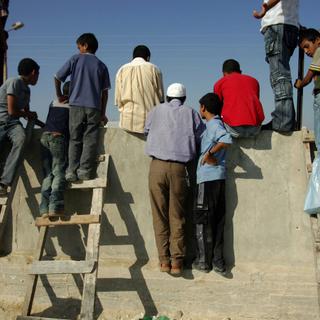


Rafah, the strategic crossing at the heart of the Israeli-Palestinian conflict
Long ReadThe status of the terminal between the Sinai desert and the Gaza Strip, recently conquered by the Israeli army, has changed over the years.
Rafah, the gateway that stands at a crossroads between empires, has watched its share of conquerors come and go: Pharaoh Thutmose III, Napoleon Bonaparte and British General Edmund Allenby, among others. On Tuesday, May 7, Israeli army tanks entered and seized the border crossing with Egypt. Here is a look back at the eventful history of a city that has played a key role in the Israeli-Palestinian conflict since 1948.
1906: The boundary between Ottoman Palestine and British-ruled Egypt
The border between Egypt and Palestine dates back to 1906. On October 1 of that year, representatives from Britain and the Sublime Porte (referring to the seat of the Ottoman government in Istanbul) − the powers that controlled the two territories − signed a border agreement. The separation between the Ottoman province of Palestine and British-ruled Egypt ran from Rafah on the Mediterranean Sea to Taba on the Red Sea.
On paper, Rafah was cut in two, but the Bedouin tribes were still able to roam from one side to the other. The conquest of Palestine by the British Armed Forces in 1917, at the cost of heavy fighting in Gaza, underscored the artificial nature of this border, essentially a line in the sand.
1948: A crossing point for Nasserite Egypt
During the first Arab-Israeli war of 1948, following the British withdrawal from Palestine and the declaration of independence by the state of Israel, the Gaza region was the last holdout against the Zionist forces. Under pressure from London and Washington, David Ben-Gurion, the founding father of the young Jewish state, decided not to attack the area, which was defended by Egyptian troops.
The contingent, which included rising officer Gamal Abdel Nasser, withdrew to Cairo via Rafah. The Israeli-Egyptian armistice of January 7, 1949, created the Gaza Strip, a narrow coastal territory populated by 80,000 inhabitants and 200,000 refugees. The Egyptian regime, which declined to extend its sovereignty there, became the default administrator. For the governors of Gaza, who came from Cairo, where Nasser took power in 1954, Rafah was the mandatory crossing point.
1967: A landmark between two occupied territories
On June 5, 1967, the start of the Six-Day War, the Israeli army took control of the southern Gaza Strip in just a few hours. By the end of the day, the seventh division of the Egyptian army, deployed around Rafah, was overwhelmed. The 60 kilometers of road between Arish, in the Sinai and Khan Yunis were littered with the bodies of soldiers. The war ended on June 10 with a resounding victory for Israel, which, in addition to the Gaza Strip, conquered the West Bank, the Golan Heights and the Sinai Peninsula.
You have 76.3% of this article left to read. The rest is for subscribers only.
